1998 PONTIAC BONNEVILLE climate control
[x] Cancel search: climate controlPage 91 of 395
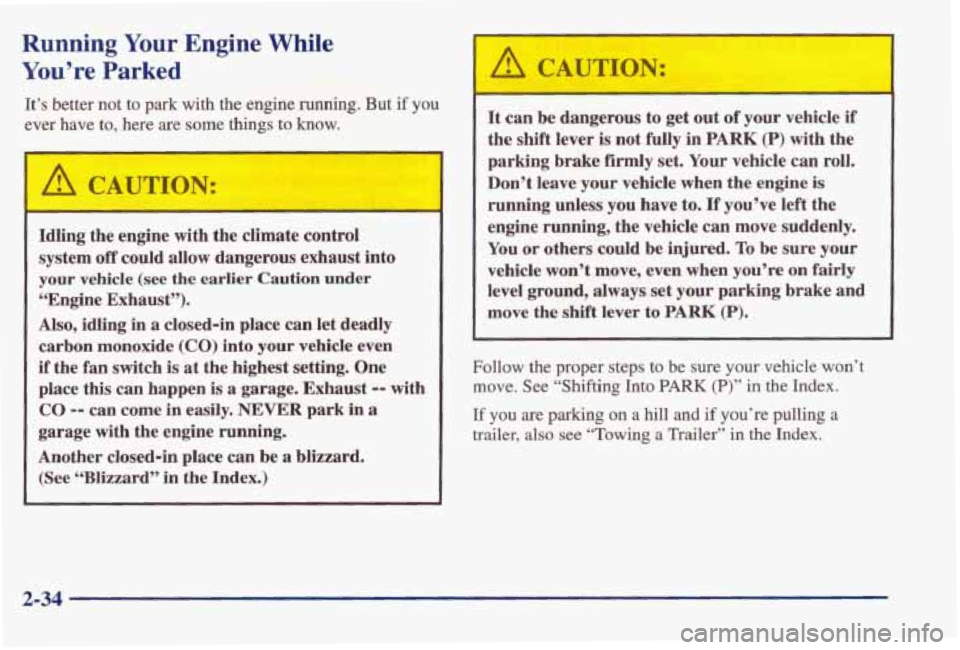
Running Your Engine While
You’re Parked
It’s better not to park with the engine running. But if you
ever have to, here are some things to know.
&A CAUTION:
Idling the engine with the climate control
system
off could allow dangerous exhaust into
your vehicle
(see the earlier Caution under
“Engine Exhaust”).
Also, idling in a closed-in place can let deadly
carbon monoxide
(CO) into your vehicle even
if the fan switch is at the highest setting. One
place this can happen is a garage. Exhaust
-- with
CO -- can come in easily. NEVER park in a
garage with the engine running.
Another closed-in place can be
a blizzard.
(See
“Blizzard” in the Index.)
-
1
I
It can be dangerous to get out of your vehicle if
the shift lever is not
fully in PARK (P) with the
parking brake
firmly set. Your vehicle can roll.
Don’t leave your vehicle when the engine
is
running unless you have to. If you’ve left the
engine running, the vehicle can move suddenly.
You or others could be injured.
To be sure your
vehicle won’t move, even when you’re
on fairly
level ground, always set your parking brake and
move the shift lever
to PARK (P).
Follow the proper steps to be sure your vehicle won’t
move. See “Shifting Into
PARK (P)” in the Index.
If you are parking on a hill and if you’re pulling a
trailer, also see “Towing a Trailer” in the Index.
2-34
Page 114 of 395
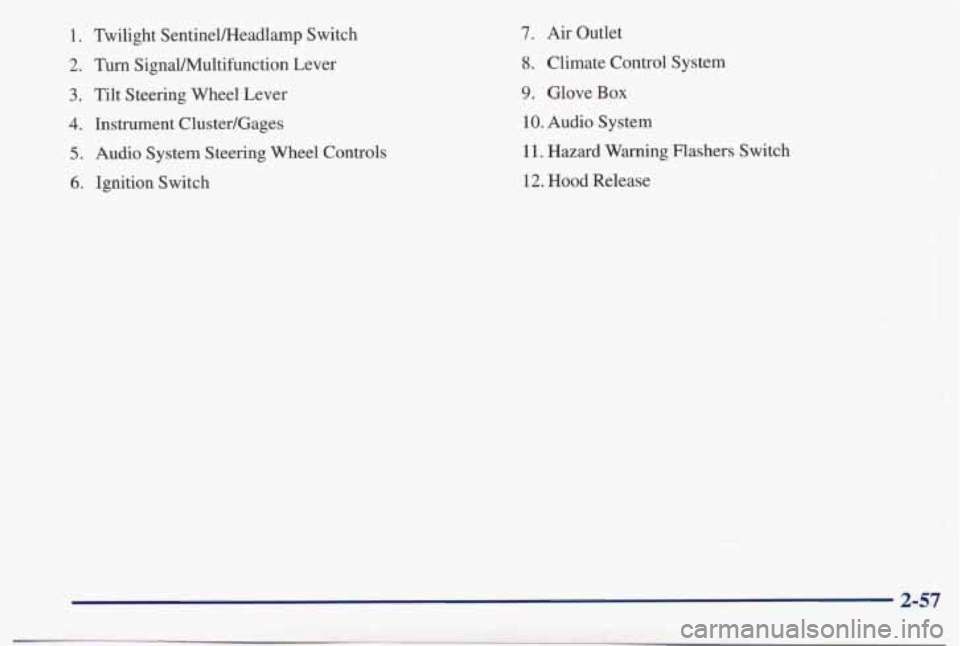
1. Tbilight SentineVHeadlamp Switch
2. Turn SignaVMultifunction Lever
3. Tilt Steering Wheel Lever
4. Instrument Cluster/Gages
5. Audio System Steering Wheel Controls
6. Ignition Switch
7. Air Outlet
8. Climate Control System
9. Glove Box
10. Audio System
1 1. Hazard Warning Flashers Switch
12. Hood Release
Page 121 of 395
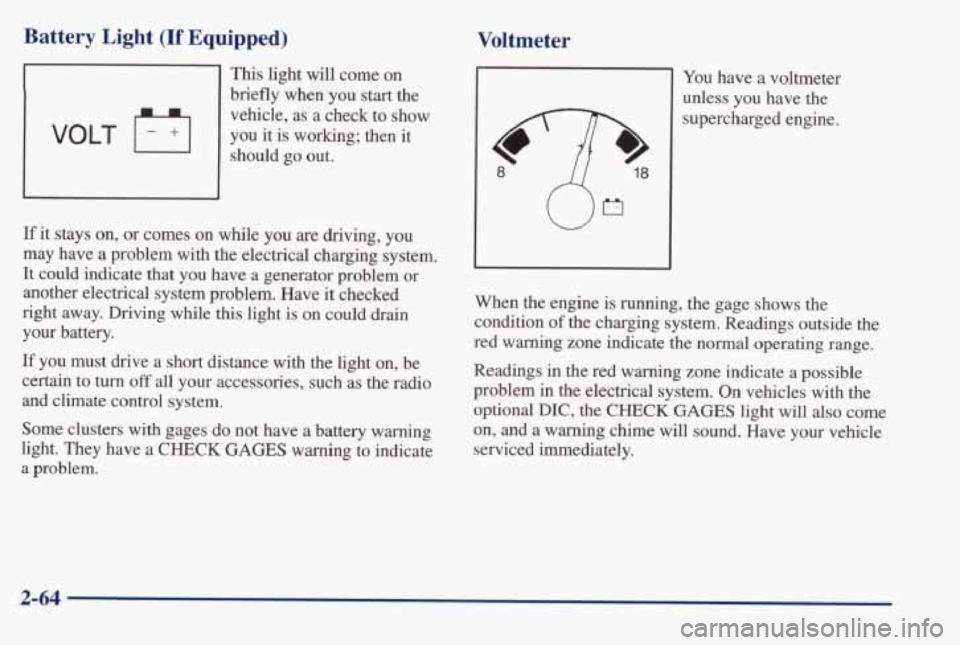
Battery Light (If Equipped)
This light will come on
briefly when you start the
vehicle, as a check to
show
should go out. VOLT F+I you it is working; then it
If it stays on, or comes on while you are driving, you
may have a problem with the electrical charging system.
It could indicate that you have a generator problem or
another electrical system problem. Have it checked
right away. Driving while
this light is on could drain
your battery.
If you must drive a short distance with the light on, be
certain to turn off all your accessories, such as the radio
and climate control system.
Some clusters with gages do not have a battery warning
light. They have
a CHECK GAGES warning to indicate
a problem.
Voltmeter
I You have a voltmeter
unless you have the
supercharged engine.
When the engine is running, the gage shows the
condition
of the charging system. Readings outside the
red
warning zone indicate the normal operating range.
Readings
in the red warning zone indicate a possible
problem in the electrical system.
On vehicles with the
optional DIC,
the CHECK GAGES light will also come
on, and
a warning chime will sound. Have your vehicle
serviced immediately.
2-64
Page 143 of 395
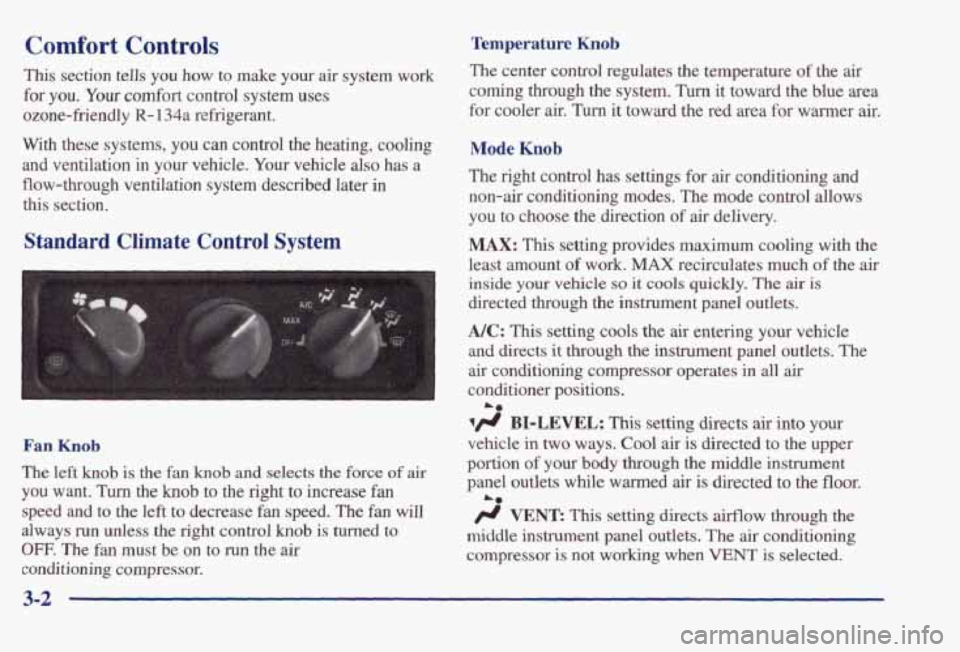
Comfort Controls Temperature Knob
This section tells you how to make your air system work
for
you. Your comfort control system uses
ozone-friendly
R- 134a refrigerant.
With these systems, you can control the heating, cooling
and ventilation
in your vehicle. Your vehicle also has a
flow-through ventilation system described later
in
this section.
Standard Climate Control System
Fan Knob
The left knob is the fan knob and selects the force of air
you want. Turn the knob to the right to increase fan
speed and to the left to decrease fan speed. The fan will
always run unless the right control
knob is turned to
OFF. The fan must be on to run the air
conditioning compressor. The center control regulates the temperature
of the air
coming through the system.
Turn it toward the blue area
for cooler
air. Turn it toward the red area for wanner air.
Mode Knob
The right control has settings for air conditioning and
non-air conditioning modes. The mode control allows
you to choose the direction of
air delivery.
MAX: This setting provides maximum cooling with the
least amount
of work. MAX recirculates much of the air
inside your vehicle so it cools quickly. The air is
directed through the instrument panel outlets.
NC: This setting cools the air entering your vehicle
and directs it through the instrument panel outlets. The
air conditioning compressor operates in all air
conditioner positions.
1fl BI-LEVEL: This setting directs air into your
vehicle in two
ways. Cool air is directed to the upper
portion
of your body through the middle instrument
panel outlets
while warmed air is directed to the floor.
@ VENT: This setting directs airflow through the
middle instrument panel outlets. The air conditioning
compressor
is not working when VENT is selected.
A0
A*
Page 144 of 395
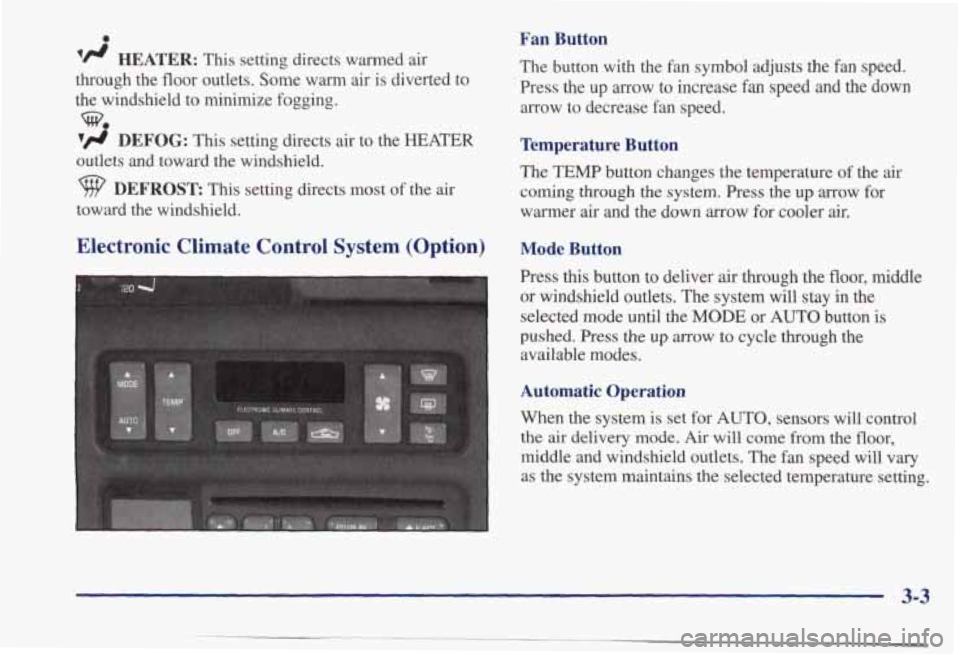
0
‘fl HEATER: This setting directs warmed air
through the floor outlets. Some warm air is diverted to
the windshield to minimize fogging.
vfl DEFOG: This setting directs air to the HEATER
outlets and toward the windshield.
w.
DEFROST: This setting directs most of the air
toward the windshield.
Fan Button
The button with the fan symbol adjusts the fan speed.
Press the up
arrow to increase fan speed and the down
arrow to decrease fan speed.
Temperature Button
The TEMP button changes the temperature of the air
coming through the system. Press the up arrow for
warmer
air and the down arrow for cooler air.
Electronic Climate Control system (option) Mode Button
Press this button to deliver air through the floor, middle
or windshield outlets. The system will stay in the
selected mode until the
MODE or AUTO button is
pushed. Press the
up arrow to cycle through the
available modes.
Automatic Operation
When the system is set for AUTO, sensors will control
middle and windshield outlets. The
fan speed will vary
as the system maintains the selected temperature setting.
I the air delivery mode. Air will come from the floor,
Page 297 of 395
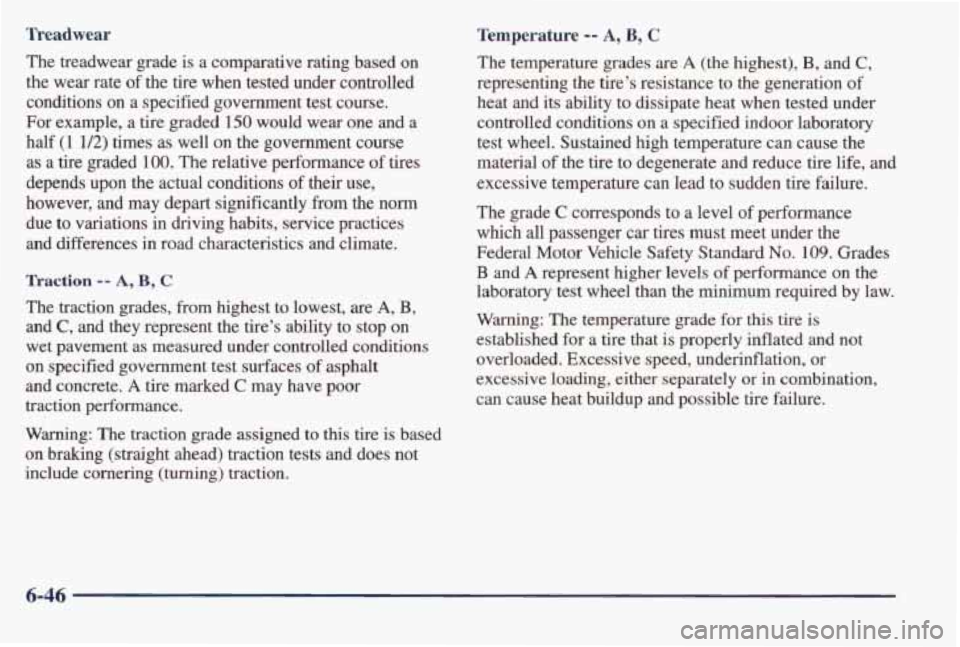
Treadwear
The treadwear grade is a comparative rating based on
the wear rate
of the tire when tested under controlled
conditions on a specified government test course.
For example, a tire graded 150 would wear one
and a
half (1 1/2) times as well on the government course
as a tire graded 100. The relative performance of tires
depends upon the actual conditions
of their use,
however, and may depart significantly from the norm
due to variations
in driving habits, service practices
and differences in road characteristics and climate.
Traction -- A, B, C
The traction grades, from highest to lowest, are A, B,
and C, and they represent the tire’s ability to stop on
wet pavement as measured under controlled conditions
on specified government test surfaces of asphalt
and concrete.
A tire marked C may have poor
traction performance.
Warning: The traction grade assigned
to this tire is based
on braking (straight ahead) traction tests and does not
include cornering (turning) traction.
Temperature -- A, B, C
The temperature grades are A (the highest), B, and C,
representing the tire’s resistance to the generation of
heat and its ability to dissipate heat when tested under
controlled conditions on a specified indoor laboratory
test wheel. Sustained high temperature can cause the
material
of the tire to degenerate and reduce tire life, and
excessive temperature can lead to sudden
tire failure.
The grade
C corresponds to a level of performance
which
all passenger car tires must meet under the
Federal Motor Vehicle Safety Standard
No. 109. Grades
B and A represent higher levels of performance on the
laboratory test wheel
than the minimum required by law.
Warning: The temperature grade for this tire is
established for a tire that is properly inflated and not
overloaded. Excessive speed, underinflation, or
excessive loading, either separately or in combination,
can cause heat buildup and possible tire failure.
6-46
Page 374 of 395
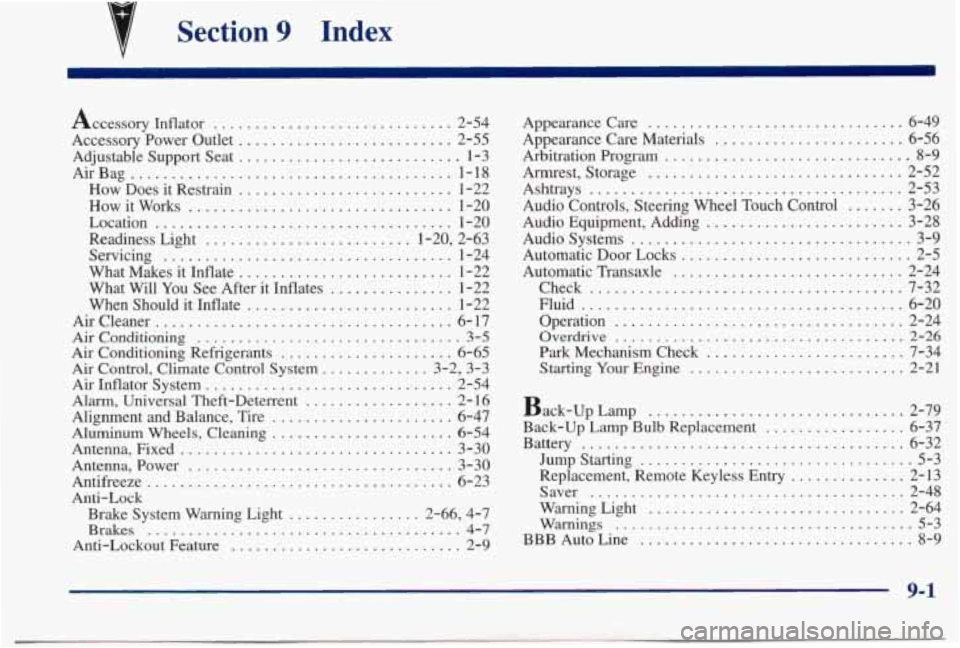
Section 9 Index
Accessory Inflator ............................. 2-54
Accessory Power Outlet
.......................... 2-55
Adjustable Support Seat
........................... 1-3
AirBag
....................................... 1-18
How Does it Restrain
... .................. 1-22
How
it Works ................................ 1-20
Location
.................................... 1-20
Readiness Light
......................... 1.20. 2.63
Servicing
................................... 1-24
What Makes it Inflate
.......................... 1-22
What Will
You See After it Inflates ............... 1-22
When Should it Inflate
......................... 1-22
Air Cleaner .................................... 6- 17
Airconditioning
................................ 3-5
Air Conditioning Refrigerants ..................... 6-65
Air Control. Climate Control System
............. 3-2. 3-3
Air Inflator System
.............................. 2-54 Appearance Care
............................... 6-49
Appearance Care Materials
....................... 6-56
Arbitration Program
.............................. 8-9
Armrest. Storage
............................... 2-52
Ashtrays
...................................... 2-53
Audio Equipment. Adding
........................ 3-28
Audio Systems
.................................. 3-9
Automatic Door Locks
............................ 2-5
Automatic Transaxle
............................ 2-24
Check
.. : ................................... 7-32
Fluid
....................................... 6-20
Operation
................................... 2-24
Overdrive
................................... 2-26
Park Mechanism Check ........................ 7-34
Audio Controls. Steering Wheel Touch Control
....... 3-26
Starting Your Engine
.......... ......... 2-21
Alarm. Univ6rsal Theft-Deterrent .................. 2- 16
Alignment and Balance. Tire
...................... 6-47 Back-up amp 2-79
Aluminum Wheels. Cleaning
...................... 6-54 Back-up Lamp Bulb Replacement 6-37
Antenna. Fixed
................................. 3-30 Battery 6-32
Antenna. Power
................................ 3-30 Jumpstarting 5-3
Antifreeze
..................................... 6-23 Replacement. Remote Keyless Entry 2-13
Anti-Lock Saver 2-48
Brakes ...................................... 4-7 Warnings 5-3
Anti-Lockout Feature ............................ 2-9 BBB Auto Line 8-9
...............................
.................
.......................................
.................................
..............
......................................
............................... Brake System Warning Light .......... . . 2-66. 4-7 WarningLight 2-64 ....................................
.................................
9-1
Page 376 of 395
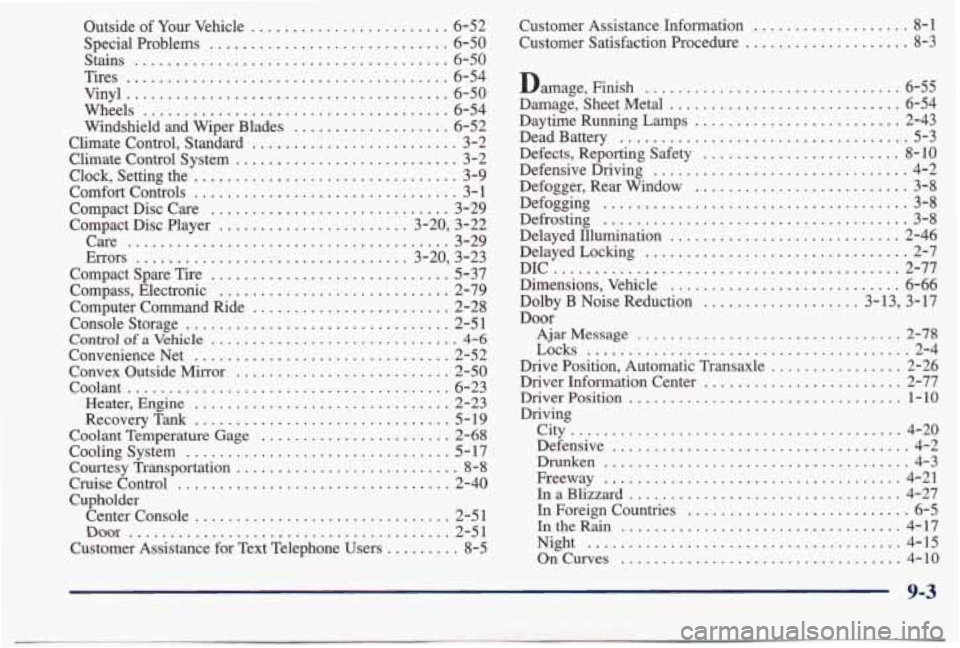
Outside of Your Vehicle ................ ... 6-52
Special Problems
............................. 6-50
Stains ...................................... 6-50
Tires
....................................... 6-54
Vinyl
....................................... 6-50
Wheels
..................................... 6-54
Windshield and Wiper Blades
................... 6-52
Climate Control. Standard
......................... 3-2
Climate Control System
........................... 3-2
Clock. Setting the
................................ 3-9
Comfortcontrols
................................ 3-1
Compact Disc Care
............................. 3-29
Compact Disc Player
....................... 3-20, 3-22
Care
....................................... 3-29
Errors
................................. 3-20. 3-23
Compact Spare Tire
............................. 5-37
Compass. Electronic
............................ 2-79
Computer Command Ride
........................ 2-28
Console Storage
................................ 2-5 1
Control of a Vehicle .............................. 4-6
Convenience Net ............................... 2-52
Convex Outside Mirror
.......................... 2-50
Coolant
....................................... 6-23
Heater. Engine
............................... 2-23
RecoveryTank
............................... 5- 19
Coolant Temperature Gage
....................... 2-68
CoolingSystem
................................ 5-17
Courtesy Transportation
........................... 8-8
CruiseControl ................................. 2-40
Cupholder Center Console
............................... 2-51
Customer Assistance for Text Telephone Users
......... 8-5
Door ....................................... 2-51 Customer Assistance Information
................... 8-1
Customer Satisfaction Procedure
.................. 8-3
Damage. Finish
............................... 6-55
Damage. Sheet Metal
............................ 6-54
Daytime Running Lamps
......................... 2-43
Dead Battery
................................... 5-3
Defects. Reporting Safety
........................ 8-10
Defensive Driving ............................... 4-2
Defogger. Rear Window
.......................... 3-8
Defogging
..................................... 3-8
Defrosting
..................................... 3-8
Delayed Illumination ............................ 2-46
Delayed Locking
................................ 2-7
DIC
.......................................... 2-77
Dimensions. Vehicle
............................ 6-66
Dolby
B Noise Reduction ................... 3-13. 3-17
Door
Ajar Message ................................ 2-78
Locks ....................................... 2-4
Drive Position. Automatic Transaxle
................ 2-26
Driver Information Center
........................ 2-77
DriverPosition
................................. 1-10
Driving
City
........................................ 4-20
Defensive
.................................... 4-2
Drunken
..................................... 4-3
Freeway
.................................... 4-21
InaBlizzard
................................. 4-27
In Foreign Countries
........................... 6-5
IntheRain
.................................. 4-17
OnCurves
.................................. 4-10
Night
...................................... 4-15
9-3